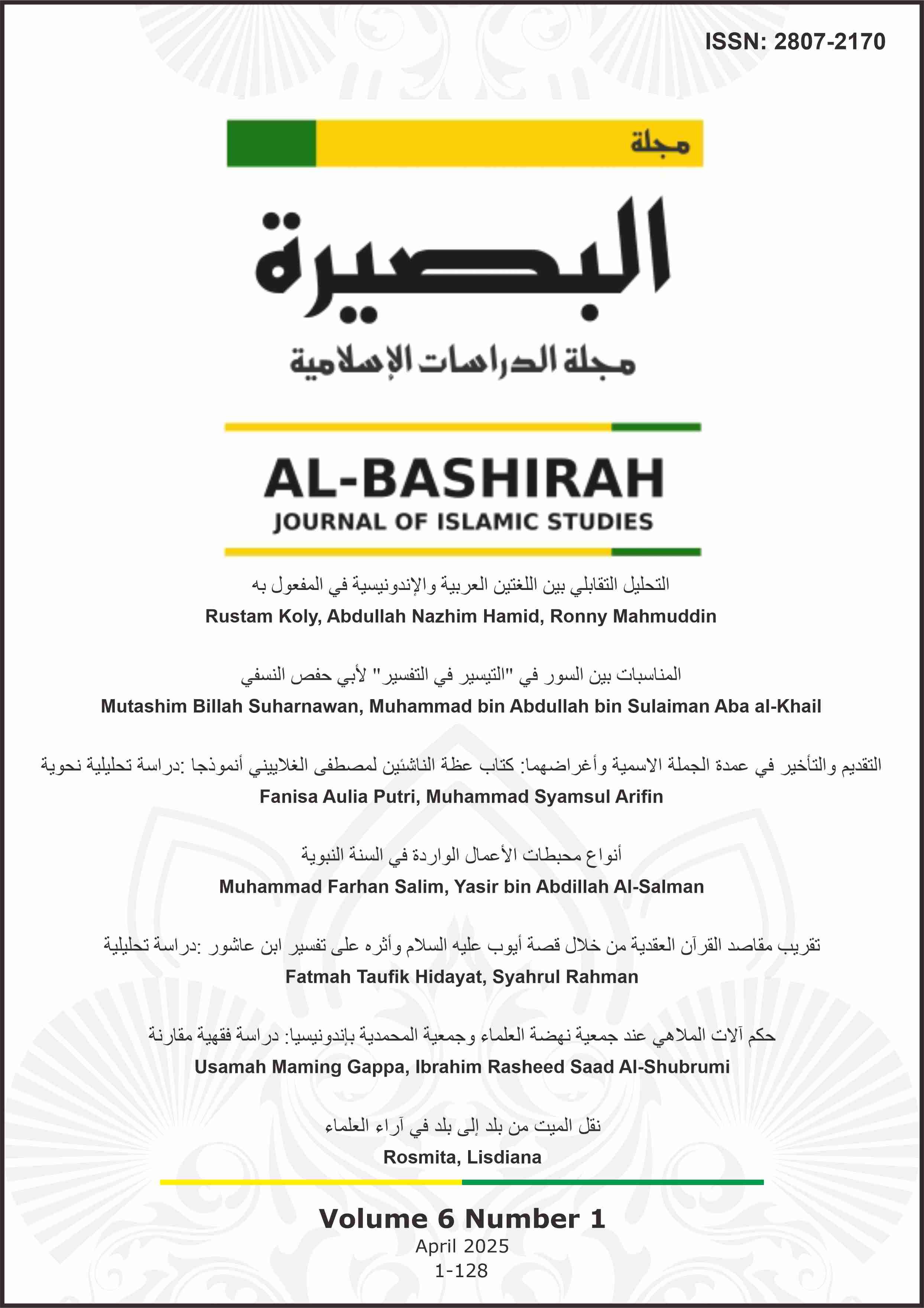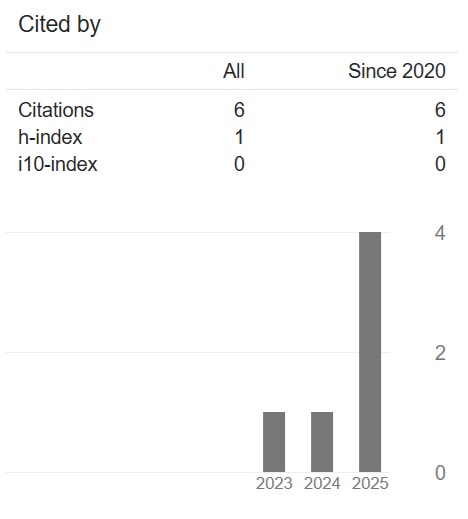التقديم والتأخير في عمدة الجملة الاسمية وأغراضهما: كتاب عظة الناشئين لمصطفى الغلاييني أنموذجا (دراسة تحليلية نحوية)
Preposing and Postposing in the Core Elements of Nominal Sentences and Their Purposes: A Syntactic Analysis of Muṣṭafā Al-Ghalāyīnī’s ʿiẓat Al-Nāshīʾīn
DOI:
https://doi.org/10.36701/bashirah.v6i1.2061Keywords:
Taqdīm, Taʾkhīr, Nominal Sentence, Syntax, Muṣṭafā al-GhalāyīnīAbstract
Muṣṭafā al-Ghalāyīnī’s ʿIẓat al-Nāshīʾīn is a renowned work known for instilling values of morality, etiquette, and nationalism since colonial times. The phenomena of taqdīm (preposing) and taʾkhīr (postposing) in this text play a crucial role in shaping the reader’s understanding of the content, making it essential to clarify their meanings to avoid misinterpretation of the intended message. This study aims to identify the types of taqdīm and taʾkhīr in the core components of nominal sentences (jumla ismiyyah) and explain their purposes as found in ʿIẓat al-Nāshīʾīn. The study adopts a qualitative methodology, applying three approaches: descriptive for data analysis, library research for data collection and object study, and theoretical linguistics as the analytical framework. Data were collected from 1,120 sentences across 44 sections, with 15 selected purposively as samples. The data collection technique used is simak (observation), including listening, transcribing, and recording, followed by analysis using the distributional method with direct constituent analysis and syntactic segmentation. The findings reveal variations of taqdīm and taʾkhīr in nominal sentence structures, totaling 533 sentences. These include obligatory and permissible preposing/postposing of the subject (mubtadaʾ) and predicate (khabar), including in kāna and inna constructions. The purposes of taqdīm and taʾkhīr include emphasis, specification, drawing special attention, comparison, reasoning, expression of hope, reinforcement of meaning, informing unaware interlocutors, semantic restriction (qaṣr), and affirming intent or eliminating doubt. The study recommends that future researchers analyze taqdīm and taʾkhīr in verbal sentences (jumla fiʿliyah), understand the order of core versus supplementary elements (ʿumda vs. faḍla), or adopt a historical-comparative linguistic (diachronic) approach.
Downloads
References
Khaldūn, ʻAbd al-Raḥmān ibn. Muqaddimah Ibn Khaldūn, al-Dār al-ḍahabīyah, 1420 H.
Ibn 'Aqīl. Bahā al-Dīn Abdullah. Syarḥ Ibn 'Aqīl, Cet. I, al-Qāhirah: Dār Miṣr, 1980.
Al-Zubaidī, Muḥammad bin Muḥammad. Tāj al-‘Arūs min Jawāhir al-Qāmūs. Cet. II. Al-Kuwait: Maṭba’ah al-Ḥukūmah al-Kuwait
al-ārifīn, Muhammad Syams. al-Basīṭ fī al-I'rāb. Cet. I, Guntur: Jāmi'aj ḍar al-Islām Guntur, 2021.
al-Gulāyīnī, Muṣṭafā. Jāmi' al-Dars al-'Arabiyyah. cet. II, Indonesia: Maktabah al-Wādī, 2021.
al-Gulāyīnī, Muṣṭafā. 'Iẓah al-Nāsyi'īn. cet. IX, Dimasq: Dār al-Mi'rāj, 2017.
al-Makārim, 'Alī Abū. al-Jumlah al-Ismiyyah. Qāhirah: Muassasah al-Mukhtār, 2006.
Barakāt, Ibrāhīm Ibrāhīm. al- Naḥw al-'Arabī. cet. I, Miṣr: Dār al-Nasyr, 2007.
Bakr, Muḥammad ṣalāh al-Dīn. al-Ma'nā al-Nahwī Mafhūmuhu wa Mukawwanātuhu. Cet. I, Kuwait: Dār al-Manẓūmah, 1981.
bū al-Sya'īr. al-Taqdīm wa al-Ta'khīr baina al-Qāidah al-Nahwiyyah wa al-Qīmah al-Balāgiyyah fī Sūrah al-Baqarah. Jāmi'ah Muhammad al-ṣiddīq bin Yaḥyā, 2015.
ṣāliḥ al-Sāmirātī, Fāḍil. Ma'ānī al-Nahw. Cet. I, Oman: Dār al-Fikr, 2000.
Fayyāḍ, Sulaimān. al-Nahw al-'Aṣrī. Markaz al-Ahrām, 1995.
Achmad Suyuthi, Imam. "Nilai-nilai Pendidikan Islam Perspektif Syaikh Musthofa Al-Ghalayaini Dalam Kitab ’Idhatun An-Nasyi’in". Universitas Islam Negeri Sunan Ampel, 2019.
Reza Hamidi, Saddam, Muassomah, و Muhammad Husnil Mubarak. "Aplikasi Taqdim Wa Takhir Fii Juz Amma: Kajian Uslubiyah". Ajamiy: Jurnal Bahasa dan Sastra Arab 12, No.1 (يونيو، 2023). http://dx.doi.org/10.31314/ajamiy.12.1.185-193.2023.
Sudaryanto. Metode dan Aneka Teknik Analisis Bahasa. 1 ط. Yogyakarta: Sanata Dharma University Press, 2015.
Wahyuni, Imelda. Genealogi Bahasa Arab Perkembangannya Sebagai Bahasa Standar. Sleman: Deepublish, 2017.



.jpg)









